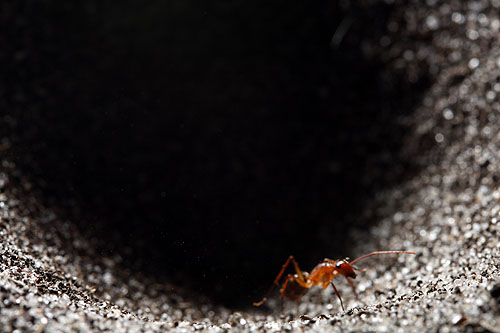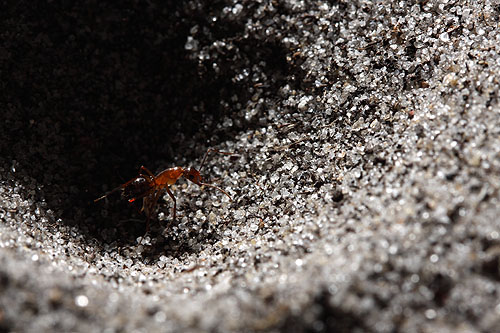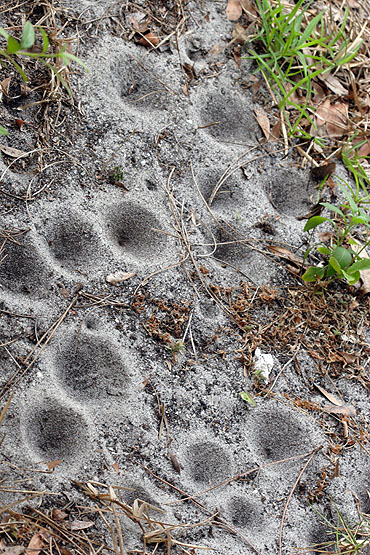
An ant, climbing from the pit of a predatory ant lion.

The predator, buried in sand at the base of the pit, hurls a volley of debris towards its target.

Caught in the falling sand, the ant slides back into the pit.

The ant tries to escape, and again the unseen predator hurls a load of sand into her path.

No matter which way the ant turns, the ant lion adjusts its aim, sending up clouds of sand and preventing the ant from gaining traction on the steep walls of the pit.

In the end, the ant lion wins.

A tight crop of the previous image shows the jaws of the ant lion reaching up around the waist of the ant.

Removed from its pit, the predator is revealed to be little more than a set of jaws attached to an enormous stomach. These fierce creatures are the immature form of a delicate dragonfly-like insect.

The adult ant lion.

From the human vantage point, the ant lion minefield looks less menacing. Each pit conceals a larva at the bottom.
photo details (attack series): Canon 100mm f2.8 macro lens on a Canon EOS 50D
ISO 100, 1/250 sec, f9.0, 550EX flash off-camera behind pit
(larval portrait): Canon MP-E 65mm 1-5x macro lens on a Canon EOS 50D
all photos except adult ant lion taken at the Archbold Biological Station in Florida;
the adult was photographed in California using a Canon EOS D60

Science fiction and horror have nothing on the real, everyday world at ground level. Nice set of images. Thanks.
Wow! Very cool photos! How much time did it take to capture those moments?
Amazing photos!
Thanks Alex, amazing indeed!
Wonderful!
Ah! Brings back memories of childhood, tossing ants into the pits...
Sometimes Hymenoptera may have their revenge (:
http://www.helsinki.fi/~mkolkkal/leijona/loisolento.html
(an antlion's parasitoid in action)
nopoles- wow, that's amazing! Thanks for sharing the link.
I have grown to love ants as well as seeds
Is the ant a species of Camponotus?
Thanks Alex for Jo's photo
I used to work with Jo when she worked @ Wacol
Great work !
I see you have some french friends : http://www.linternaute.com/science/biologie/photo/l-univers-microscopiq…
Fantastic!
ææåèè» ç¨ç·¨ç¹ã
So cool...
Surely this is the inspiration for the sarlaac pit in Starwars..?
heheh
Heheh, cool. Thanks.